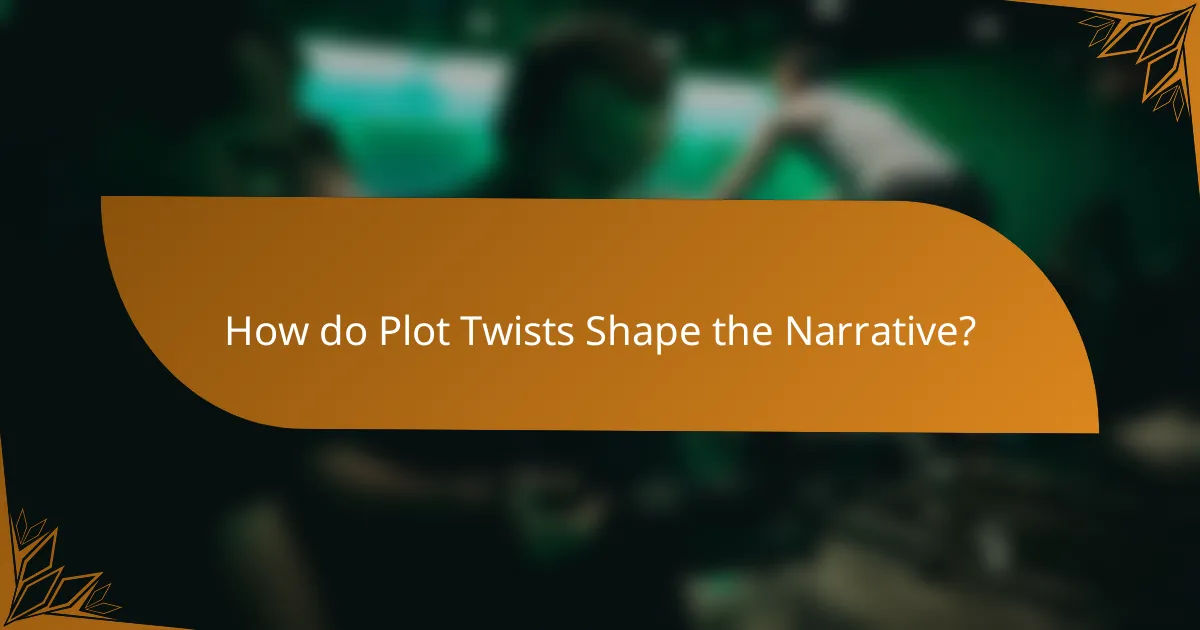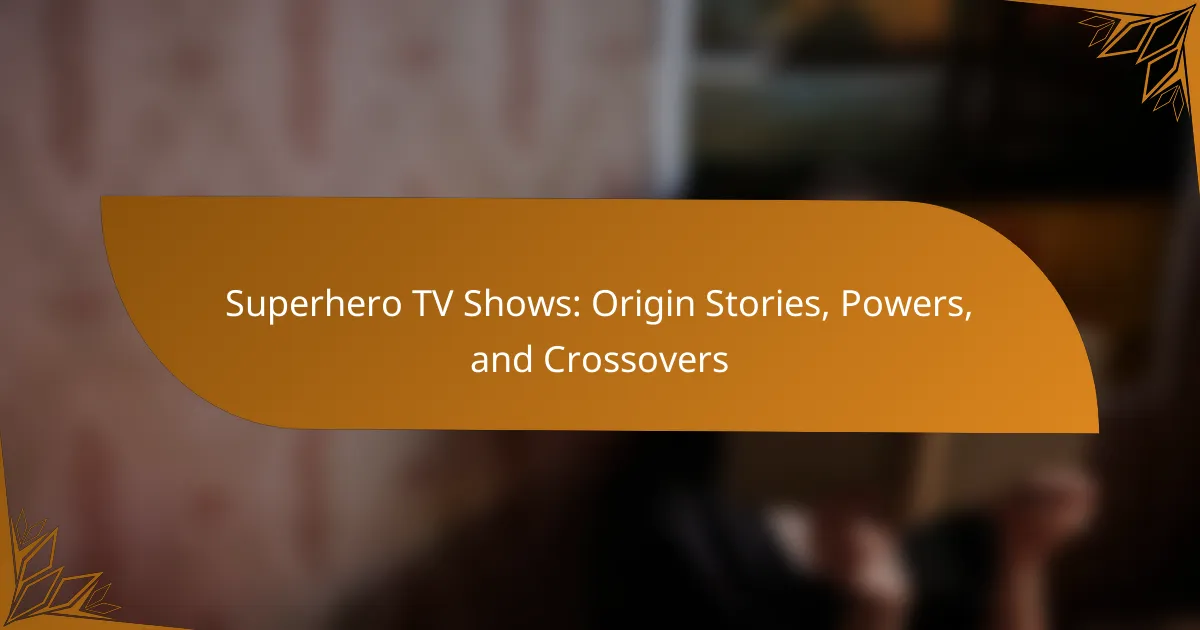Thrilling action TV series are characterized by intense sequences, fast-paced storytelling, and high-stakes conflicts, often featuring complex characters who face significant challenges. Key elements include plot twists that alter audience expectations, notable stunts that enhance visual appeal, and high production values that contribute to overall impact. Successful series like “24” and “Breaking Bad” exemplify these traits, utilizing suspenseful moments and cliffhangers to engage viewers. The integration of character arcs with plot developments and stunts plays a crucial role in maintaining audience interest and emotional connection throughout the narrative.

What Defines Thrilling Action TV Series?
Thrilling action TV series are defined by their intense sequences, fast-paced storytelling, and high-stakes situations. These series often feature complex characters who face significant challenges. Plot twists are common, keeping viewers engaged and surprised. Notable stunts and action sequences enhance the excitement. The narrative usually involves a clear conflict, often between good and evil. High production values contribute to the overall impact. Audience engagement is crucial, often achieved through cliffhangers and suspenseful moments. Successful examples include “24” and “Breaking Bad,” which exemplify these defining traits.
How do plot twists enhance the viewing experience?
Plot twists enhance the viewing experience by creating surprise and engaging the audience. They challenge viewers’ expectations and provoke emotional responses. This unpredictability keeps the narrative fresh and stimulating. Research shows that plot twists can significantly increase viewer satisfaction. A study by the University of California found that unexpected plot developments lead to higher engagement levels. Viewers are more likely to discuss and share content with surprising twists. This social interaction further amplifies the enjoyment of the series. Overall, plot twists serve to deepen the connection between the audience and the story.
What are the most impactful plot twists in action TV series?
Impactful plot twists in action TV series include major character revelations, unexpected betrayals, and shocking deaths. One notable twist occurs in “24” when Jack Bauer’s trusted ally is revealed to be a traitor. This twist significantly alters the audience’s perception of loyalty. In “Lost,” the reveal that John Locke is actually dead changes the narrative’s direction. “The Walking Dead” features the sudden death of major characters, which leaves viewers in disbelief. In “Arrow,” the reveal of the identity of the main villain, Prometheus, surprises fans and reshapes the storyline. These twists often redefine character relationships and elevate the stakes in the series.
How do plot twists contribute to character development?
Plot twists significantly enhance character development by revealing hidden traits and motivations. These unexpected turns challenge characters’ beliefs and prompt growth. For instance, a betrayal may expose a character’s vulnerability, leading to introspection. This process often results in a more complex persona. Characters may evolve in response to new circumstances brought on by plot twists. As a result, viewers gain deeper insights into their psyche. This dynamic fosters engagement and emotional investment in the story. Ultimately, plot twists serve as catalysts for character transformation.
What role do character arcs play in action TV series?
Character arcs are crucial in action TV series as they provide depth and development to the characters. These arcs allow viewers to connect emotionally with the characters’ journeys. They often reflect personal growth, moral dilemmas, or transformations that enhance the narrative. For example, a hero may start as a reluctant participant and evolve into a decisive leader. This progression keeps audiences engaged and invested in the story. Moreover, character arcs can create tension and conflict, driving the plot forward. A well-crafted arc adds layers to the action, making it more than just physical confrontations. Ultimately, character arcs enrich the storytelling experience in action TV series.
How do character arcs evolve throughout a series?
Character arcs evolve throughout a series by undergoing significant changes in response to events and conflicts. Initially, characters may start with a specific goal or personality trait. As the series progresses, they face challenges that force them to adapt and grow. This growth can manifest as increased complexity, moral dilemmas, or shifts in relationships.
For example, a character may begin as a hero but face situations that test their values. This can lead to moments of doubt or transformation, showcasing their development. The evolution of character arcs is often driven by the narrative’s plot twists and character interactions.
Research indicates that well-developed character arcs enhance viewer engagement and emotional investment. A study by the University of Southern California found that character development is crucial for maintaining audience interest in long-running series.
What are some examples of well-developed character arcs?
Examples of well-developed character arcs include Walter White from “Breaking Bad” and Jon Snow from “Game of Thrones.” Walter White transforms from a mild-mannered chemistry teacher to a ruthless drug kingpin. His journey showcases moral decay and the consequences of choices. Jon Snow evolves from a perceived outcast to a respected leader. His arc emphasizes themes of honor, loyalty, and identity. Both characters experience significant growth and change, illustrating complex human emotions and motivations. These transformations are central to the narrative and resonate with audiences, making them memorable examples of character development.
Why are stunts significant in action TV series?
Stunts are significant in action TV series because they enhance visual excitement and engage viewers. They create a sense of realism and urgency that is essential for the genre. High-quality stunts can elevate the storytelling by intensifying emotional moments. For instance, a well-executed chase scene can heighten tension and keep audiences on the edge of their seats. Additionally, stunts often showcase the physical capabilities of actors, adding to their character’s credibility. The use of skilled stunt performers can also improve safety during complex sequences. Overall, stunts are integral in maintaining the pace and energy that define action TV series.
What types of stunts are commonly featured?
Commonly featured stunts in thrilling action TV series include fight choreography, car chases, and high falls. Fight choreography often showcases martial arts techniques and combat sequences. Car chases typically involve high-speed pursuits and close calls. High falls demonstrate stunt performers jumping from significant heights, often using safety equipment. Other stunts may include explosions, parkour, and aerial acrobatics. These stunts enhance the excitement and visual appeal of the series. They are designed to captivate audiences and elevate the storytelling.
How do stunts influence audience engagement?
Stunts significantly enhance audience engagement by creating thrilling visual experiences. They capture viewers’ attention and heighten emotional responses. High-quality stunts often lead to increased excitement and anticipation. This can result in higher viewer retention rates during episodes. Research shows that action sequences can boost audience adrenaline levels. For example, a study by the University of Southern California found that thrilling scenes can increase heart rates by up to 30%. Engaging stunts also encourage social sharing and discussions on social media platforms. This further amplifies audience interest and involvement in the series.

How do Plot Twists Shape the Narrative?
Plot twists significantly shape the narrative by altering the audience’s expectations and deepening engagement. They introduce unexpected developments that challenge characters’ motivations and decisions. This shift often leads to heightened emotional responses from viewers. For instance, a plot twist can reveal a character’s hidden agenda, changing the perceived dynamics of relationships. Such revelations can prompt viewers to re-evaluate earlier events in the story. A well-executed plot twist can also serve to maintain suspense and intrigue throughout the series. By keeping the audience guessing, plot twists sustain interest and encourage continued viewership. In successful action TV series, these twists often align with character arcs, enhancing the overall storytelling experience.
What techniques are used to create effective plot twists?
Effective plot twists are created using techniques such as foreshadowing, misdirection, and character development. Foreshadowing subtly hints at future events, preparing the audience for surprises. Misdirection involves leading viewers to believe one outcome while concealing the true twist. Strong character development allows twists to feel organic and believable. Utilizing red herrings can distract the audience from the actual twist. Timing is crucial; revealing twists at unexpected moments maximizes impact. Additionally, building suspense throughout the narrative enhances the effectiveness of plot twists. These techniques have been employed successfully in numerous acclaimed TV series, demonstrating their effectiveness in engaging audiences.
How do writers foreshadow plot twists?
Writers foreshadow plot twists by planting subtle hints throughout the narrative. These hints can be in the form of dialogue, imagery, or character behavior. For example, a character’s seemingly innocuous comment may later reveal significant information. Additionally, visual cues or recurring symbols can signal upcoming changes in the plot. Writers often use misdirection to lead the audience away from the twist. This technique creates surprise while maintaining narrative coherence. Effective foreshadowing enhances the impact of the twist when it occurs. According to literary analysis, foreshadowing increases audience engagement and satisfaction.
What are the common pitfalls in crafting plot twists?
Common pitfalls in crafting plot twists include predictability, lack of foreshadowing, and overcomplication. Predictability occurs when twists are too obvious, leading to disengagement. Lack of foreshadowing means twists feel unearned, as viewers have no clues to support the reveal. Overcomplication can confuse the audience, making the twist hard to follow. These pitfalls undermine the impact of the twist. Effective plot twists should surprise while still feeling plausible within the story’s context.
How do character arcs drive the storyline?
Character arcs drive the storyline by providing depth and development to characters. They create emotional investment for the audience. As characters evolve, their decisions influence plot progression. This transformation often leads to conflicts and resolutions within the story. For instance, a hero’s journey typically involves overcoming personal flaws. This journey can culminate in pivotal moments that alter the course of the narrative. In many action TV series, character arcs are intertwined with thrilling plot twists. These twists often hinge on the growth or downfall of a character, enhancing suspense and engagement. Overall, character arcs serve as the backbone of storytelling, guiding the narrative structure and audience connection.
What are the stages of a character arc?
The stages of a character arc typically include the setup, the point of no return, the crisis, the climax, and the resolution. In the setup stage, the character’s initial situation and traits are established. The point of no return marks a critical decision that changes the character’s trajectory. The crisis stage involves significant challenges that test the character’s resolve. The climax represents the peak of the character’s conflict and transformation. Finally, the resolution shows the character’s new state after their journey. These stages are commonly found in narratives, illustrating character growth and change.
How do character relationships impact their arcs?
Character relationships significantly influence their arcs by driving emotional development and conflict resolution. These relationships shape motivations and decisions throughout the narrative. For instance, a protagonist’s bond with a mentor can lead to personal growth and moral dilemmas. Conversely, antagonistic relationships often create tension and obstacles, propelling the character’s journey. Research shows that character dynamics are crucial for viewer engagement in storytelling. According to a study by the University of Southern California, strong character relationships enhance audience investment and emotional response, validating their importance in character arcs.

What Makes Notable Stunts Memorable?
Notable stunts are memorable due to their execution and impact on the storyline. They often showcase exceptional skill and creativity from the performers. The visual spectacle of a well-executed stunt can captivate audiences. Stunts that involve high risk tend to leave a lasting impression. Historical examples include the car chase in “Bullitt,” which set a standard for action sequences. Additionally, stunts that enhance character development make them more impactful. For instance, a character’s growth can be highlighted through their involvement in a significant stunt. Overall, the combination of technical prowess, emotional resonance, and visual appeal makes notable stunts unforgettable.
How are stunts choreographed and executed?
Stunts are choreographed and executed through a detailed process involving planning, training, and performance. Initially, stunt coordinators design the stunts based on the script’s requirements. They create a choreography that ensures safety while achieving the desired visual impact. Next, performers undergo extensive training to master the movements and techniques involved. This training often includes rehearsals to refine timing and execution. Safety measures are prioritized, including the use of harnesses, pads, and other protective gear. Finally, the stunts are performed on set, often with multiple cameras capturing the action from various angles. This methodical approach ensures that stunts are both thrilling and safe for the performers involved.
What safety measures are taken during stunt performances?
Safety measures during stunt performances include thorough planning and rehearsals. Stunt coordinators assess risks and develop detailed safety protocols. Performers wear protective gear like helmets and pads. Safety harnesses and wires are used for high falls or aerial stunts. Medical personnel are always on standby during performances. Safety meetings are conducted before each stunt. Equipment is regularly inspected for reliability. These measures ensure the safety of all involved in stunt performances.
How do filmmakers select the right stunts for their series?
Filmmakers select stunts for their series by assessing the narrative context and character development. They consider the physical capabilities of the actors involved. Safety is a primary concern, so stunt coordinators evaluate risks associated with each stunt. Filmmakers also analyze the visual impact of stunts on the audience. Budget constraints influence the complexity and scale of stunts. Collaboration with stunt professionals ensures expertise in execution. Ultimately, the selected stunts enhance the storytelling and engage viewers effectively.
What are the trends in stunt work in modern action TV series?
Modern action TV series increasingly emphasize realism in stunt work. This trend includes the use of advanced technology for choreography. Motion capture and CGI enhance the visual impact of stunts. Additionally, there is a growing focus on training actors for practical stunts. This approach enhances authenticity and viewer engagement. Stunt coordination is becoming more collaborative with directors and writers. The integration of diverse martial arts styles is also on the rise. Furthermore, safety protocols are being prioritized to protect stunt performers. These trends reflect the industry’s evolution towards high-quality action sequences.
How has technology influenced stunt performances?
Technology has significantly influenced stunt performances by enhancing safety and precision. Advanced safety gear, such as harnesses and airbags, reduces the risk of injury. CGI and motion capture allow for the creation of elaborate stunts without physical danger. Drones provide aerial shots that capture stunts from unique angles. Virtual reality enables stunt performers to practice in simulated environments. Innovations in rigging systems allow for more dynamic movements. The integration of high-speed cameras captures stunts in slow motion for dramatic effect. These technological advancements have transformed the way stunts are conceived and executed in action TV series.
What are the most iconic stunts in recent series?
The most iconic stunts in recent series include the rooftop chase in “Money Heist.” This scene showcases intense action as characters pursue each other across buildings. Another notable stunt is the train heist in “The Mandalorian.” It features thrilling visual effects and practical effects that enhance the experience. In “Game of Thrones,” the dragon battles are also memorable. They combine CGI with live-action stunts, creating epic confrontations. The motorcycle chase in “Peaky Blinders” is another standout. It highlights high-speed action with impressive choreography. Each of these stunts has been praised for their execution and impact on the storyline.
What tips can enhance the viewing experience of action TV series?
To enhance the viewing experience of action TV series, consider watching on a large screen. A bigger display improves visual detail and immersion. Use high-quality sound systems to capture the audio dynamics of action scenes. This adds depth and excitement to the viewing experience. Adjust lighting in the room to minimize glare. A darker environment allows for better focus on the screen. Engage with fellow viewers for discussions. Sharing perspectives can deepen understanding of plot twists and character development. Take breaks between episodes to reflect on significant moments. This helps in appreciating the intricate storytelling often found in action series.
How can viewers identify effective plot twists and character arcs?
Viewers can identify effective plot twists and character arcs through clear foreshadowing and character development. Effective plot twists often have subtle hints throughout the narrative. These hints create a sense of inevitability when the twist is revealed. For character arcs, viewers should look for significant transformations in a character’s beliefs or actions. A well-developed arc shows growth or regression that is believable and resonates with the audience.
For example, in “Breaking Bad,” Walter White’s transformation from a mild-mannered teacher to a ruthless drug lord exemplifies a strong character arc. The twists in the series are often foreshadowed through earlier events, making them impactful. This combination of foreshadowing and character development helps viewers appreciate the depth of the storytelling.
What should viewers look for in stunt choreography?
Viewers should look for authenticity, safety, and creativity in stunt choreography. Authenticity ensures that the stunts align with the character’s abilities and the story’s context. Safety is paramount, as well-executed stunts minimize the risk of injury to performers. Creativity in choreography enhances visual appeal and engages the audience. Viewers should also observe the fluidity of movements, which indicates skill and practice. The use of innovative techniques can elevate the overall impact of the scene. Finally, the integration of stunts with the narrative contributes to a cohesive viewing experience.
The main entity of this article is thrilling action TV series, characterized by intense sequences, fast-paced storytelling, and high-stakes situations. The article explores key elements such as plot twists, character arcs, and notable stunts that define these series. It discusses how plot twists enhance viewer engagement and satisfaction, the significance of character development, and the role of stunts in creating excitement. Additionally, it provides examples of impactful plot twists and well-developed character arcs, while also addressing the trends and techniques in stunt choreography that contribute to the overall narrative experience.


